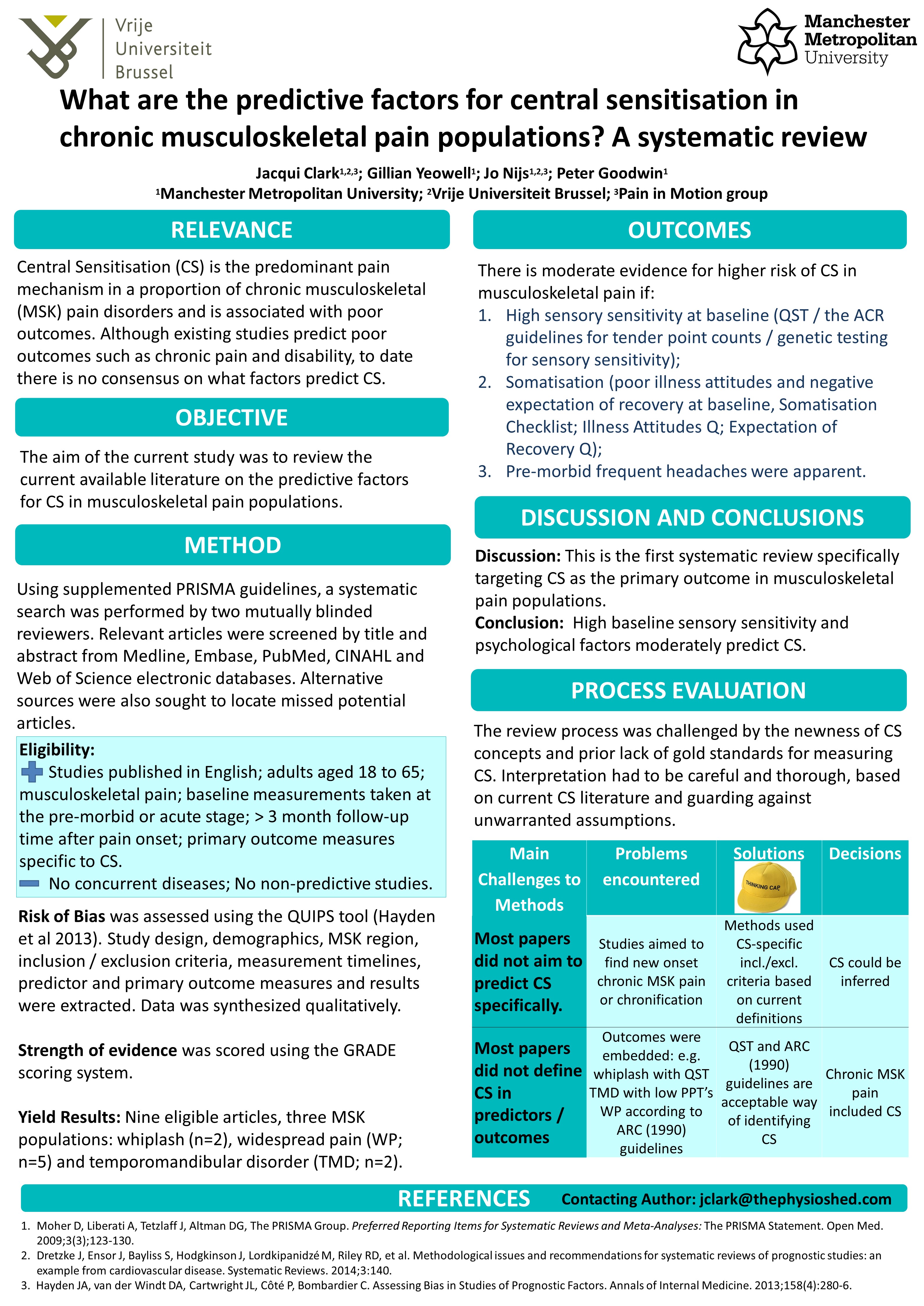This is a question most clinicians dealing with people in pain must have asked themselves many times before. We have too. Central sensitisation is a debilitating disorder of the central nervous system in so many of our patients but as yet, it is difficult to predict who is at risk of developing it. Therefore, we decided to undertake a systematic review of studies that had aimed to predict central sensitisation in musculoskeletal pain populations. Some musculoskeletal pain presentations are known to be associated with central sensitisation, such as whiplash associated disorders, chronic low back pain, temporomandibular disorder and fibromyalgia. We therefore made sure we included these presentations in our search terms.
Our search revealed very few studies (in fact, only one) specifically predicting central sensitisation but there were a number of studies predicting chronic pain. It was important to know that the studies had measured from a baseline that was before the development of central sensitisation. Hence, we included studies with baselines at the acute stage of pain or before the onset of pain. Furthermore, the term “chronic pain” only tells us the pain has been present for 3 or more months but does not detail which of the three accepted pain mechanisms may have been the predominant one. Using a Visual Analogue Scale, for example, to determine the presence of (in this case, chronic) pain does not indicate whether that pain is predominantly nociceptive, neuropathic or central sensitisation pain. Therefore, we had to look closely at the outcome measures the studies had used to identify the presence of central sensitisation. Some used quantitative sensory testing, two also used genetic (COMT) tests and some used the criteria given by the American College of Rheumatology for widespread pain, which when met infer the presence of central sensitisation. We also had the advantage of the contemporary published guidelines by Nijs et al. (2014) which enabled us to assess in more detail as to whether each article reflected the clinical presentations of central sensitisation.
Our search located 9 eligible predictive studies, six of which were longitudinal population studies which had taken baseline measures before, and in some cases long before, the onset of pain and subsequent development of central sensitisation. They had all used acceptable outcome measures for central sensitisation, even when their particular research questions had not asked specifically for central sensitisation as their primary outcome. The answers to our research question were therefore sometimes embedded.
Our results showed that there is moderate evidence for a higher risk of developing central sensitisation when in the premorbid history of the patient there was: 1) higher sensory sensitivity levels, 2) higher levels of psychological factors, particularly somatisation, and 3) the presence of frequent headaches.
For those who wish to check the study in more detail, take a look at the poster which was presented at the Pain Science in Motion Colloquium in Stockholm earlier this year. We are also delighted that this study (Clark et al. 2017) has recently been published by Pain Physician journal. We are now investigating further into the risk factors behind the development of central sensitisation. If we can spot the risks early we may be able to help our patients avoid the transition to this often debilitating disorder of the central nervous system.
Jacqui R Clark
Jacqui Clark is a physiotherapist from the United Kingdom, active in clinical practice in New Zealand and post graduate lecturing in New Zealand and Europe. She is near to completing her PhD research with Manchester Metropolitan University UK in collaboration with Vrije Universiteit Brussel, Belgium. Her current research is investigating pre-morbid factors that predict central sensitisation with particular focus on trait sensory processing and anxiety characteristics.
References and further reading:
Nijs J, Torres-Cueco R, van Wilgen CP, Girbes EL, Struyf F, Roussel N, van Oosterwijck J, Daenen L, Kuppens K, Vanwerweeën L, Hermans L, Beckwee D, Voogt L, Clark J, Moloney N, Meeus M. Applying modern pain neuroscience in clinical practice: criteria for the classification of central sensitization pain. Pain Physician. 2014;17(5):447-57.
https://www.ncbi.nlm.nih.gov/pubmed/25247901
Clark JR, Yeowell G, Nijs J, Goodwin PC, (2017) What are the predictive factors for altered central pain modulation in chronic musculoskeletal pain populations? A systematic review. Pain Physician. 2017 Sep;20(6):487-50.
https://www.ncbi.nlm.nih.gov/pubmed/28934779
